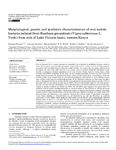| dc.description.abstract | Low soil nitrogen (N) is a major constraint for sustainable crop production in smallholder farming systems in Africa. Grain legumes such as bambara groundnuts (Vigna subterranea L. Verdc). can form N fixing symbiotic association with root nodule bacteria collectively called ‘rhizobia’; in a process that can supply sufficient N for the legume and other crops under intercrop or in rotation. There is currently insufficient information on the diversity of indigenous rhizobial populations in the soils of Lake Victoria basin in western Kenya which associate with bambara groundnuts. In this study, one local bambara groundnut accession was used to trap root nodule bacteria from four soils obtained from farmers’ fields in Lake Victoria basin, western Kenya. Sixty four rhizobial isolates were obtained from the soils and morphologically characterized on Yeast Mannitol Extract Agar (YEMA) with Congo red and Bromothymol blue (BTB). Molecular evaluation was done using 16S rRNA genes to distinguish between the isolates. Results of morphological characterization showed majority (70%) of the isolates had very fast and fast growth rates on YEMA, 26% were intermediate while 3% were slow growers. The fast, very fast and some intermediates (70 %) showed positive acid reaction while the rest showed positive reaction in alkaline conditions on YEMA with BTB. The 16S rRNA gene sequences had greater than 97% similarity to diverse genera including Rhizobium sp., Bradyrhizobium sp., Burkholderia sp. and Agrobacterium sp. previously isolated from crop plants. Phylogenetic analysis of eighteen representative sequences showed the presence of three clades with Rhizobium and Agrobacterium type sequences occurring in a single clade while Bradyrhizobium and Burkholderia type sequences clustered into separate clades. In glasshouse experiments, seven isolates identified as Bradyrhizobium sp. and Burkholderia sp. and one Rhizobium sp. produced significantly (P≤0.05) higher nodule number per plant which were all effective with correspondingly high total biomass values of above 1.1 g per plant. The rest of the isolates showed significantly (P≤0.05) low levels of nodulation most of which were ineffective and resulted in significantly (P≤0.05) less plant dry matter. Isolates BAMKis12, BAMKis8, BAMKis4, BAMKbay8 and BAMsp3 genetically characterized as Bradyrhizobium sp. and Burkholderia sp. respectively can potentially be used as biofertilizers in inoculation programmes to improve the productivity of bambara groundnuts in the region. | en_US |

